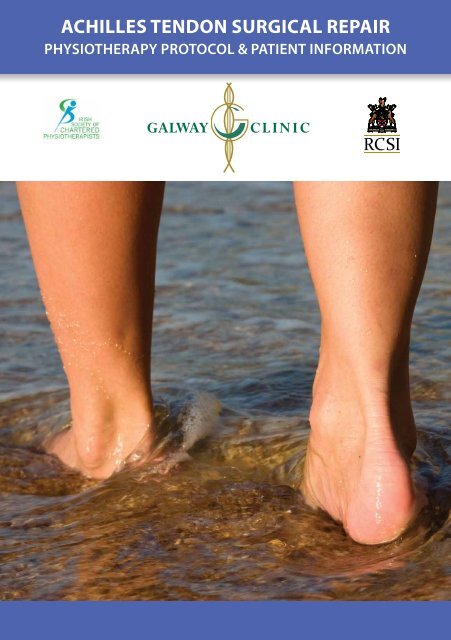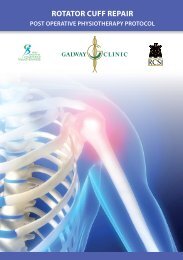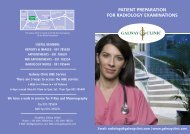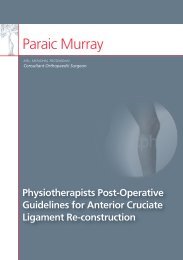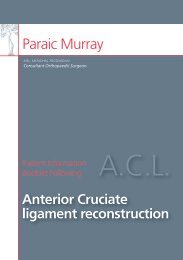PoSt achilleS tenDon SURGical RePaiR - Galway Clinic
PoSt achilleS tenDon SURGical RePaiR - Galway Clinic
PoSt achilleS tenDon SURGical RePaiR - Galway Clinic
You also want an ePaper? Increase the reach of your titles
YUMPU automatically turns print PDFs into web optimized ePapers that Google loves.
ACHILLES TENDON SURGICAL REPAIR<br />
PHYSIOTHERAPY PROTOCOL & PATIENT INFORMATION
Welcome to the GalWay clinic<br />
This information booklet has been designed to provide guidelines on the physiotherapy<br />
rehabilitation following Achilles tendon repair.<br />
You may further your reading by using the references and links provided at the end of this<br />
booklet and discuss any queries with your physiotherapist and/or orthopaedic surgeon.<br />
2<br />
Achilles Tendon
<strong>PoSt</strong> <strong>achilleS</strong> <strong>tenDon</strong> <strong>SURGical</strong> <strong>RePaiR</strong><br />
The Achilles tendon is generally considered to be the strongest and largest tendon in the body and<br />
can withstand forces high enough to allow the performance of many activities such as running,<br />
jumping, toe-standing, stair climbing (1).<br />
However, due to a relatively poor blood supply the tendon is not very resilient to repetitive micro<br />
trauma and thus irritation, degeneration and rupture can occur. (1). Ruptures commonly occur<br />
spontaneously in healthy active individuals aged between 30 to 50 years. There does not have to be<br />
a history of calf or heel pain. Often, a sudden eccentric or lengthening force applied to a dorsiflexed<br />
foot can cause rupture.<br />
Deconditioning, advancing age and over exertion are all risk factors (1). It is generally considered that<br />
surgery is the preferred choice with a smaller chance of re-rupture when compared to conservative<br />
management (2,3). However, the risk of infection may be higher.<br />
RecommenDation PRioR to Rehabilitation<br />
Physiotherapy may not be required in the acute phase of healing but is crucial once adequate healing<br />
has taken place – normally around six weeks post surgery.<br />
Part of the role of your Chartered Physiotherapist will be to translate the following guidelines into<br />
a straightforward format for you to gain from. The better you are informed the more likely you will<br />
recover and be able to prevent recurrence of your injury.<br />
The following guidelines are for chartered physiotherapists treating patients post Achilles tendon<br />
repair.<br />
3
PhySiotheRaPy GUiDelineS foR <strong>achilleS</strong><br />
Rehabilitation <strong>PoSt</strong> SURGeRy<br />
Always liaise with the orthopaedic surgeon or the <strong>Galway</strong> <strong>Clinic</strong> physiotherapy team for any specific<br />
post operative instructions.<br />
StaGe i: 0 - 8 WeekS<br />
A cast for serial splinting is normally applied for approximately the first six weeks before being<br />
removed. The patient may be non-weight bearing (NWB) or partial weight bearing (PWB) during this<br />
time.<br />
A walking cast/or boot may be used at weeks 6 to 10 to prevent overuse during normal activities of<br />
daily living.<br />
StaGe 1: 7 - 8 WeekS<br />
1. Assess the incision site for signs of adequate healing and/or signs of infection.<br />
2. Control swelling with elevation as required. (PRICE, cryo-cuff therapy).<br />
3. Use oily cream or emollients to prevent drying of scar.<br />
4. Begin gentle active and passive range of movement exercises. Light stretches to<br />
first point of resistance only.<br />
Please refer to stage I of the advice sheet attached at the end of these guidelines.<br />
5. Begin gentle manual therapy as required to mobilise stiff joints e.g. the subtalar<br />
joint. Use soft tissue massage as appropriate.<br />
6. Also consider global core stability, hip and knee strengthening exercises. Stretch<br />
gluteal, hamstring and quadriceps muscle groups.<br />
you should be able to progress to resisted ankle exercises usually after Week 8.<br />
4
StaGe ii : 8 - 12 WeekS<br />
1. Walking cast/boot may be removed. A heel raise may be applied to accommodate<br />
lack of dorsiflexion if needed.<br />
2. Gait re-education.<br />
3. Towel-calf stretch (gastrocnemius/soleus/tibialis posterior) stretch 10-30 seconds by<br />
three daily. It is important not to reproduce pain. Progress to standing<br />
gastrocnemius, soleus, tibialis posterior stretches.<br />
4. Theraband exercises, inversion, eversion, plantiflexion, dorsiflexion performed in<br />
sets of 3 x 15 repetitions each.<br />
5. Sitting calf raises. Progress to bilateral standing calf raises (as a guide, start with<br />
25% effort on affected side). Aim to perform 12 repetitions by 3 sets three-four<br />
times a week.<br />
6. Begin bilateral ‘eccentric’ calf raises. As above but ensure heels SLOWLY descend to<br />
neutral level. Aim to perform 5 repetitions by 3 sets three-four times a week.<br />
7. Begin neuromuscular exercises, e.g. unilateral leg balance, wobble board, podiatron<br />
(electronic wobble board).<br />
8. Bilateral standing, small knee joint bends to approximately 45º of knee flexion.<br />
Progress to unilateral small knee bends.<br />
9. Step ups, step downs on 5cm step height. Front/sideways/back as able.<br />
10. Gymnasium rehabilitation, begin light cycle ergometer or cross-trainer if ankle<br />
range allows, leg press, quadriceps bench bilateral to unilateral, swimming.<br />
StaGe iii : 12 WeekS onWaRDS<br />
WeekS 12 - 16<br />
1. Ensure gait is normal without any aids.<br />
2. Ensure full range of ankle joint movement.<br />
3. Ensure satisfactory mobility in the subtalar joint, compare with the opposite side.<br />
4. Continue with gymnasium workouts.<br />
5. Continue with cycle, stepper, cross-trainer, leg press/calf press<br />
6. Swimming,<br />
7. Outdoor cycling<br />
5
WeekS 16 onWaRDS<br />
Progress to unilateral gastrocnemius/soleus/tibialis posterior strengthening in standing.<br />
May begin rowing at the gymnasium.<br />
confiRm With oRthoPaeDic SURGeon oR GalWay clinic<br />
PhySiotheRaPy team:<br />
Jogging to Running<br />
Agility Drills<br />
Jumping / Hopping<br />
Plyometrics<br />
oveRall oUtlook (1)<br />
1. The majority of people may return to normal activity levels with either surgical or<br />
non-surgical treatment.<br />
2. Most studies indicate a better outcome with surgery.<br />
3. Athletes can expect a faster return to activity with a lower incidence of injury<br />
recurrence.<br />
4. Typically as the rupture site heals, a small lump may remain from the scarring.<br />
5. Weight bearing commonly begins at about six weeks with a heel support.<br />
6. Returning to running or athletics is traditionally in approximately four to six months.<br />
However, with motivation and rigorous physiotherapy, some elite athletes may<br />
return to athletics as early as 3 months after injury.<br />
6
aDvice Sheet of SamPle exeRciSeS:<br />
Part of the role of your chartered physiotherapist will be to explain, demonstrate and<br />
ensure you have correct technique when performing the following sample exercises.<br />
The better you are informed the more likely you will recover and be able to prevent<br />
recurrence of your injury.<br />
StaGe i (6-8 WeekS)<br />
Begin gentle active range of motion exercises.<br />
light stretches to first point of resistance (without pain).<br />
Core stability exercises. Liaise with your chartered physiotherapist, e.g. buttocks muscles<br />
(gluteus medius, maximus), Abdominals, Bridging, Straight Leg Raise, Inner Range<br />
Quadriceps, Hamstrings, Quadriceps and Gluteal stretches.<br />
7
StaGe ii (8 - 12 WeekS)<br />
8<br />
Progress to<br />
calf/Soleus stretching.<br />
Goal: aim for 3 sets of 30 second stretches daily.<br />
theraband strengthening exercises:<br />
a) Dorsiflexion b) Plantarflexion<br />
c) Inversion d) Eversion<br />
Goal: aim for 3 sets of 15 repetitions 3 x week.
StaGe ii (continUeD)<br />
Progress from seated calf raises to bilateral standing raises. Start with only 25% effort on<br />
affected side. Goal: aim for 3 sets of 12 repetitions 3 x week.<br />
Begin bilateral ‘eccentric’ calf raises. As above but ensure heels SLOWLY descend to<br />
neutral level.<br />
Goal: aim to perform 5 repetitions by 3 sets three-four times a week.<br />
Beginning balance exercises on one leg with eyes open, one leg standing on pillow with<br />
eyes open, progress to eyes closed.<br />
Do not forget: Step ups/step downs & small knee bends.<br />
Gymnasium work may include:<br />
Light cycle ergometer, Cross-trainer, Bilateral leg press & Swimming.<br />
note: stop if you feel any sharp pain or if your calf, ankle or foot becomes hot or swollen.<br />
Seek advice from your chartered physiotherapist or general practitioner immediately.<br />
9
StaGe iii (Week 16 onWaRDS)<br />
Confirm with your Orthopaedic Surgeon or chartered physiotherapist before you<br />
commence more dynamic activities e.g.:<br />
Jogging to running<br />
Dynamic Balance training and Agility drills<br />
Jumping/hopping, Plyometrics<br />
10
StaGe iv (21-26 WeekS)<br />
An isokinetic test may be performed in the<br />
<strong>Galway</strong> <strong>Clinic</strong> to help clarify the time to return to<br />
sporting or manual activities. Isokinetic Testing is a<br />
computerised and therefore objective measurement<br />
of muscle strength and endurance. It will help us<br />
assess and therefore address the presence of any<br />
potential problems associated with muscle strength,<br />
muscle imbalance, flexibility, posture and patterns<br />
of movement that may delay return to sporting or<br />
manual activity.<br />
RefeRenceS<br />
References:<br />
1. Marano, Henry M.D. (2005), ‘Achilles tendon rupture’,<br />
http://www.emedicine.com/SPoRtS/fulltopic/topic1.htm, pp1.-10<br />
2. Lo IK, Kirkley A, Nonweiler B, Kumbhare, DA (1997), ‘Operative versus non- operative<br />
treatment of acute achilles tendon ruptures: a quantitative overview.’,<br />
<strong>Clinic</strong>al Journal of Sports Medicine, 7(3):207-211)<br />
3. Bhandari M et al (2002), ‘Treatment of acute Achilles tendon ruptures:<br />
A Systematic overview and metaanalysis’, <strong>Clinic</strong>al Orthopaedics and<br />
related research, 400:190-200.<br />
Other useful sites<br />
National Institute of <strong>Clinic</strong>al Excellence (NICE)<br />
http://www.nice.org.uk<br />
Best Treatments (British medical Journal)<br />
http://www.besttreatments.co.uk/btuk/home.html<br />
Glossary:<br />
NWB - Non-Weight Bearing<br />
PWB - Partial Weight Bearing<br />
ADL - Activities of Daily Living<br />
PRICE - Protection, Rest, Ice, Compression, Elevation<br />
Dorsiflexion - The turning of the foot or the toes upward<br />
Plantarflexion - The turning of the foot or toes downward<br />
Eccentric - The lengthening of a tendon under tension.<br />
11
The <strong>Galway</strong> <strong>Clinic</strong><br />
oRthoPaeDic & SPoRtS chaRteReD PhySiotheRaPy<br />
Doughiska, Co. <strong>Galway</strong>, Ireland<br />
Phone: + 353 (0)91 785 450/457 Fax: + 353 (0)91 785 453 E-Mail: physio@galwayclinic.com<br />
www.galwayclinic.com


